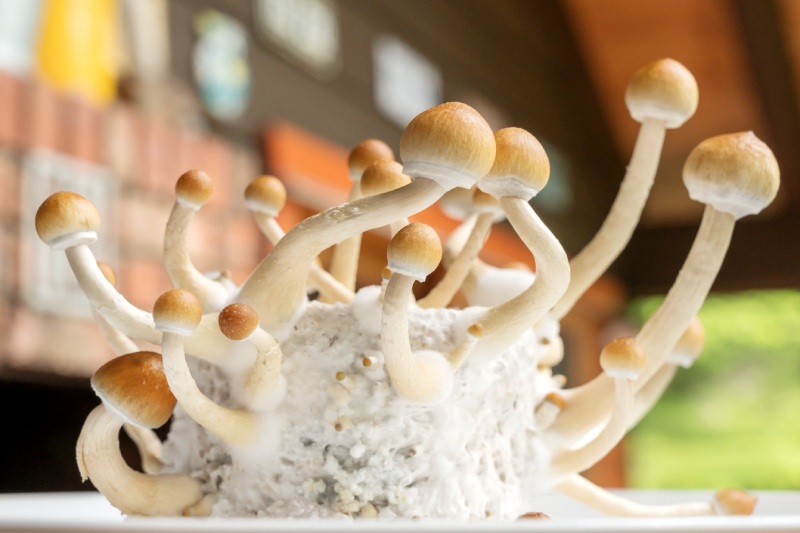Scientists created novel molecules from psilocybin, the active component of “magic mushrooms,” in a recently published study. These substances are developed to lessen the time that psilocybin produces psychedelic effects while preserving its therapeutic advantages. This discovery, which was reported in the Journal of Medicinal Chemistry, may represent a major advancement in the treatment of mental illness and provide hope to people who are afflicted with these prevalent but frequently disabling illnesses.
The limitations of the available treatments for anxiety and depression are the driving force behind this ground-breaking study. Many people experience depression that is resistant to therapy, meaning that standard drugs are ineffective in alleviating their symptoms. Scientists have focused on psilocybin, a naturally occurring substance present in some mushrooms that has been utilized for centuries in conventional medical techniques, in light of these difficulties.
According to study author Sheetal Raithatha, director of preclinical development at Enveric Biosciences Inc., “recent advances in the field of psychedelic research have unveiled significant long-term neurological benefits linked to the psychotherapeutic application of hallucinogenic compounds such as psilocybin, DMT, ketamine, and LSD, in patients struggling with severe depression and anxiety disorders.”
“These molecules are revolutionizing the mechanism of pharmacological intervention for such diseases due to their ability to promote neuronal plasticity (being recently classed as neuroplastogenic agents). Even though these classic psychedelics are demonstrating notable therapeutic value, their clinical application is significantly hindered by their potent hallucinogenic effects, with episodes lasting up to 6 hours from the time of dosing. This feature alone, requiring extended clinical supervision, dramatically limits their feasibility as a psychiatric drug.”
“Taking advantage of our ability for novel synthetic innovation, Enveric Biosciences recognized an opportunity to generate new medicines, inspired by foundational psychedelics, that can alleviate the significant clinical hurdles and get these ground-breaking neuroplastogenic therapeutics to patients in dire need of new treatment options,” Raithatha explained.
In order to investigate psilocybin’s potential in a more regulated and clinically viable manner, scientists set out to synthesize new psilocin derivatives, which are the compounds that psilocybin transforms into within the body and gives it its psychedelic effects. Their goal was to alter the psilocybin’s pharmacokinetics, or how the drug enters, circulates, is digested, and leaves the body. In the end, they had a collection of twenty-eight distinct compounds.
Both in vitro (test tube) and in vivo (live creature) approaches were used in the investigation. Initially, human liver and intestinal enzymes were used to test the metabolic stability of each novel chemical. A pharmacokinetic study in male C57BL/6 mice—a popular model in medical research—came next. The mice were administered with different dosages of either psilocybin or one of the new compounds, and blood samples were taken at various intervals to determine the concentrations of both the new and psilocin. In order to evaluate these chemicals’ psychoactive and anxiolytic (anxiety-reducing) qualities, the researchers also tested the behavior of mice.
These chemicals have different metabolic profiles, according to the study. While some were better digested in the liver, others remained more stable in the gastrointestinal system. Because the body processes the molecules differently, customized treatments may be possible, potentially providing patients with mental health illnesses with more effective and individualized therapies.
Similar to psilocybin itself, some of the novel compounds, especially those containing ester and thiocarbonate linkages, were found to cause substantial psychedelic effects in mice. Significantly, these effects were obtained at blood psilocin peak concentrations that were lower than those of psilocybin, indicating that the modified compounds may have comparable therapeutic advantages but at a lower risk of the strong and protracted hallucinations that are connected to psilocybin. These substances showed notable anxiolytic effects in the marble-burying test, a behavioral experiment designed to measure mice’s anxiety levels, especially in mice exposed to a mild chronic stress paradigm.
“The goal of this study was to generate a series of novel derivatives of the natural prodrug psilocybin and screen them for altered metabolic processing,” Raithatha told PsyPost. “Enveric Biosciences designed 28 new chemical entities and employed a comprehensive strategy of synthesis and functional screening to identify several novel psilocin prodrugs with candidate potential. We demonstrated that distinct modifications in the chemical structure of psilocybin led to notable changes in the way this natural prodrug was absorbed and metabolized by the body.”
“These structural modifications resulted in reduced overall systemic exposure of the psychoactive metabolite, psilocin, driven solely by where the molecule was processed by the body. Even with altered pharmacokinetic profiles, these novel psilocin prodrugs retained the long-term anti-anxiety benefits equivalent to psilocybin. These results suggest that our novel psilocin prodrugs have the potential to attenuate the duration of psychedelic effects while maintaining long-term therapeutic benefits.”
These findings suggest a bright future in which psilocybin compounds that have been altered may be utilized to treat anxiety and depression more successfully and with fewer adverse effects. The possible shortening of the duration of psychoactive effects is one of the most important consequences of this research. As long-lasting psychedelic experiences now necessitate lengthy therapeutic supervision, this could make psilocybin-based treatments more feasible and accessible. This could be a key obstacle to the widespread adoption of psilocybin-based treatments.
Subsequent research endeavors aimed at delving deeper into these substances’ pharmacological characteristics will ultimately culminate in human clinical trials. Millions of individuals worldwide could benefit from the development of new, more potent medicines for depression and anxiety as a result of this research. In addition to paving the way for new developments in psychopharmacology, the study highlights the value of searching nature for possible therapeutic discoveries.
“These interpretations are based on established rodent models of pharmacokinetics and behavior, even though our novel psilocin prodrugs produce reduced exposure, and potentially reduced psychedelic effects,” stated Raithatha. “Human clinical trials will be necessary to truly confirm that a mitigated psychedelic experience has been achieved with lasting therapeutic benefit.”
Papers by Sheetal A. Raithatha, Jillian M. Hagel, Kaveh Matinkhoo, Lisa Yu, David Press, Sarah G. Cook, Govinda Sharma, D. Dhananjaya, Glynnis Jensen, Jessica B. Lee, Charlie Cai, Jonathan Gallant, Jaideep Bains, Joseph E. Tucker, and Peter J. Facchini were published in the journal “Novel Psilocin Prodrugs with Altered Pharmacological Properties as Candidate Therapies for Treatment-Resistant Anxiety Disorders.”





